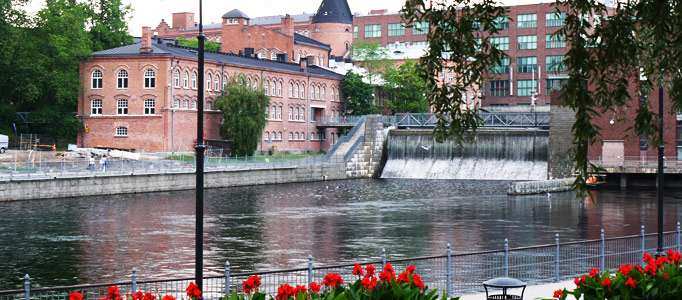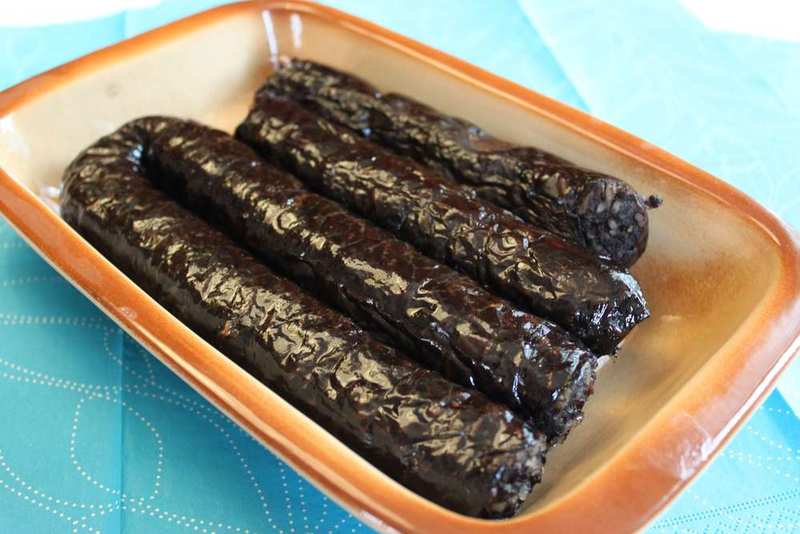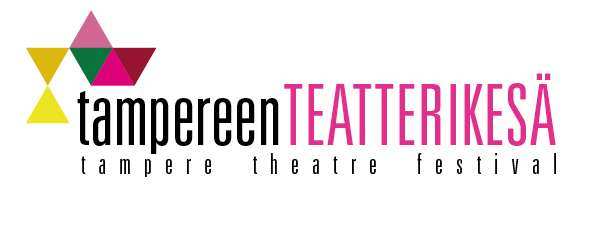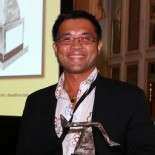IN THE CULTURE OF ONE WORLD
On Human Rights & Censorship, World Cultures, Wanderlust and Criticism Without Borders
TRAVEL & DISPLEASURE | Under a midnight sun in Finland, my hours with the Nordic wolves

Situated between two lakes, Tampere is a thriving industrial city in Finland | Photo © MEK Finnish Tourist Board
By Randy Gener
TAMPERE, FINLAND | What is it? I asked. His ruddy cheeks gleamed with sort-of mischief under a rocking midnight sun. He had unwrapped black-blood dry sausages and held them out for me to see.
It was August. Finland’s summer weather held fast to its comfortable warmth. Festivities refused to fade into autumn.
I looked at the sausages tucked inside the folds of a mustard yellow napkin with curiosity. The young, fairly husky, longhaired Lapland Finn mumbled something I could not make out, pronounce or spell.
What was that again? He repeated a Finnish word, sounding as if he were tuned in to an abrupt, low-voiced frequency.
Reindeer meat. Right?
His name was Veli-Jussi; he was 23 years old. We were getting acquainted in a Tampere park under a bright Midsummer night. He and his two close buddies, Samu and Lehtola, already had plenty to drink at a popular jazz pub called Paappa Music Pub, the only venue in town offering live music every night of the week. In the summer, there’s a lively terrace overlooking the main street and the Tammerkoski rapids.
After recognizing me as the New Yorker putzing around in the lobby of Tampereen Teatterikesä, Veli introduced himself to me as a drama-loving student from the extreme northern province of Lapland, near the border of Finland and Sweden. Raised in the Lapland capital of Rovaniemi, he studied at a professional theater company housed inside a theater building called the Lappia House (designed by Alvar Aalto). Rovaniemi Theatre has premiered works by many Finnish writers, especially those that told stories about the north.
“Reindeer steak is famous in Lapland,” Lehtola said. “Sauteed reindeer (or reindeer stew) tastes good,” Samu, interjected. “Have you had it?”
“No, this is not reindeer,” Veli added. “This is made of pork, crushed rye, pig’s blood. Flour.”
Ah, Finnish sausage.
Veli chuckled. “It is called mustamakkara. It is authentic here in Tampere. I had it for breakfast this morning. They served it with eggs and lingonberry jam. I took these sausages for us to have after tonight’s jazz concert. It’s very good with vodka.”

Mustamakkara, the black sausage, is an authentic Finnish cuisine that originated in Tampere region.
The label on the vodka bottle confirmed that we had not been sharing a generic Finlandia brand. Veli’s vodka of choice was Kossu — or Koskenkorva Viina, a vodka-like clear spirit.
The four of us were hanging out on a park bench not far from the marketplaces and glittering restaurants that dotted the banks of the Tammerkoski River. Holding hands, ambling restfully and while others dilly-dallied around the Tampere park were lots of other young Finns (some with dark-brown and a few with orange-red hair) and many Scandinavians enjoying the last hours of a temperate Nordic night.
“Eat, Randy. Mustamakkara will give you a strong energy. Great before gym workouts. You must try it.”
Samu, Karelian Finns who just returned from his girlfriend’s sauna, took a deep swig of Kossu vodka. I looked up at the enthusiastic eyes and open-hearted faces of my macho acquaintances. The sun had slowly set after midnight here in Finland, yet the sky never became completely dark. I could clearly see Lehtola’s dirty-blond whiskers even though it was close to two o’clock in the morning. We could make out each other’s quirks and grimaces as we chatted through the white night.
Veli had spotted me sitting alone on a park bench leafing through a playbill. I remember being surprised that the sky made it easy for me to make out the printed actors’ bios. Tonight I took in So Simple is Love (Så enkel är kärleken) written by Sweden’s most renowned contemporary dramatist Lars Norén. In it, two real-life Finnish acting couples from TTT Theatre (the abbreviation stands for Tampereen Työväen Teatteri, also known as the Workers Theatre) portrayed two married actors who quarreled after they performed in a revival of Who’s Afraid of Virginia Woolf?. Norén was tipping a hat to Edward Albee.
Veli was impressed when I told him that I once hung out with Norén in a cafe in Brussels. Norén is treated as a kind of god in this part of the world. This legendary dramatist told me that he is a huge fan of Albee. Norén and Albee had actually met in person. I digressed.
Daylight hours ran long during the late summer months in the city of Tampere, the third largest in Finland and the biggest inland city in the Nordic countries. Summers in Lapland where Veli comes from are shorter due to the differences in altitude. Summer in Tampere begins in late May, while summer in Lapland starts a month later and ends a month earlier than in southern Finland. Tonight was one of the last gasps of summer before the Finnish theatre season officially began in early September.
“King Gustav III of Sweden founded Tampere in the late 1700s. Did you know that?”
I smiled weakly. My mind moved elsewhere as I munched on the blood sausage he gave me. It tasted thick, chewy and cold. Mustamakkara is best eaten fresh and warm and with jam. Over late brunch the following day, Veli exhorted, “Don’t forget to finish up with milk. That’s the Finnish way.”
Although it looks strange and unappetizing, the black sausage tasted of dry oatmeal and minced onions and rye flour. It’s similar to black pudding or perhaps grilled pancakes except with pig’s blood used as batter, and all of it is stuffed inside intestines. As I noted the flecks of white fat on this piece of Tampere delicacy, I downed more vodka.
My mind made eerie leaps and drew odd connections. In Tampere, I was working hard to grasp a sense of the Finnish contemporary arts scene. I should have been resting after a day-long blitz of supertitled English translations of the Finnish language, but the country’s bright skies kept me from falling asleep. I had an overwhelming urge. Stay outside.
I segued into other topics I felt surer and more knowledgeable about. Hey, Veli, isn’t it great that a Swedish circus [Cirkus Cirkor, Scandinavia’s leading circus troupe] graces the poster of this Finnish theater festival? And I saw the latest drama by Norén in Finnish translation. In America, I had written about him extensively. Do you know Lars?
“Yeah. Lars became the new director of Folkteatern in Gothenburg.”
Finns must really appreciate the Swedes, and vice versa.
My Lapland friend paused to stare at me. His face evinced a vexed disbelief that one reserves for the terminally naïve and Nordically ignorant.
“For a long time, Randy, Swedes have been arrogant and rude to us Finns. ‘Finne’ in Swedish has two meanings. It means ‘pimple’ and ‘a Finn’ person. Finnjävel [‘Finnish devil’). Finnpajsare [an old ethnic slur].”
In Tampere: “Så enkel är kärleken / So Simple is Love” by Lars Norén. Directed by Pasi Lampela | Photo by Yehja Eweis
The good news: The language ties between Sweden and Finland is now becoming weaker and weaker. From a green canvas bag, Veli pulled out that day’s edition of the Helsinki Times. Turning to page 5 of the newspaper, he pointed to a headline: “Sweden Criticized Over Treatment of Minority Language.”
“The Swedish parliament,” the article stated, “passed a new language law which officially confirms what was long implicit — that Sweden’s principal language is Swedish.”
The new law also confirmed the status of five other “national minority” languages, which include Finnish and Torne Valley Finnish (meänkieli, a Finnish dialect spoken in the northern parts of Sweden). It was not clear whether this law, which took effect in July 2010, would “be enough to meet recent criticism from the Council of Europe over what it regards as the steady marginalization of Sweden’s minority languages, including Finnish.”
We fell silent. I stared at the small dark-blue rapids. Veli passed around a third bottle of vodka. Finland’s sky continued to rock a natural white. My new Finnish friend pulled out a can of snuff.
 Over the course of my stay in Helsinki and Tampere, I learned that Finland and Sweden have shaped eccentric regional histories all their own. Yes, these two vibrant theater cultures cooperate with each other frequently. Yet there remain instances of national rivalry, language divisions and expressions of fierce literary independence — all of which grew out of a shared 600-year history of deep subjugation and political control.
Over the course of my stay in Helsinki and Tampere, I learned that Finland and Sweden have shaped eccentric regional histories all their own. Yes, these two vibrant theater cultures cooperate with each other frequently. Yet there remain instances of national rivalry, language divisions and expressions of fierce literary independence — all of which grew out of a shared 600-year history of deep subjugation and political control.
At the same time, their open economies have always needed to look abroad for success. They are well aware that their respective languages do not widely circulate beyond their borders. Their theatre cultures are sometimes considered by some critics and many academic specialists to be not enough of an arriviste. Culture is politically used to change those hoary views.
For Finns and Swedes, artistic and cultural successes rest in a stubborn ability to adapt to changing global markets, even if sometimes economic and political contingencies require them to bite hard bullets. In January 2010, the main Consulates-General offices in Kaliningrad, Canton, Los Angeles and New York were closed. Sweden’s Embassy in Colombo, Sri Lanka, was affected during the reorganization of the foreign-affairs budget. Finnish theater remains virtually unknown in the U.S. This meant that in 2007 Finland had to bravely dive into unknown waters when Lit Moon Theatre Company of Santa Barbara, Calif., imported a selection of contemporary Finnish drama.
The whiteness of Finland’s wee hours gave a glow to my hearty-spiky-amiable-insightful encounter with these young and curious Finns. Having seen Finnish plays at the Tampere Theatre Festival (Tampereen Teatterikesä), to this day I openly wonder if a healthy surge of Finnish new voices and fresh writings could be given a greater airing and higher-stakes chances. Could Finnish-language works see a promising light of day in the U.S. I don’t know.
Well, not yet.
One thing I felt absolutely sure about. Believe it or not, mustamakkara is one of the most beloved foods in Tampere. But when the description of it is translated into less exotic English words, “black sausage” is unlikely to catch on internationally — and culinarily.
Except for those of us adventurous souls, most Americans might think it is too grotesque to eat. For breakfast. Or lunch. Glasses of milk be damned.
Would you eat black sausages?
Veli gave me snuff. I coughed. Lehtola put an arm around my shoulders. Samu replied to a text from his girlfriend on his cellphone. “She’s ready”, Samu informed us. “She put the birch branches on the wooden benches.” She’s waiting to whack us, I mumbled. Lehtola pulled me into his elbows and emitted a throaty laugh.
Earnestly, Veli implored: “Come, Randy. Let’s sauna.We won’t need towels. We’ll cool off naked in the Baltic Sea. We’ll swim. Drink beer. Then we sauna again.”
I got up and tagged along. It was splendid. We started something I have yet to Finnish. — rg
My trip to Finland was made possible by the Consulate General of Finland in New York and the Ministry for Foreign Affairs of Finland.

“Let’s sauna,” Veli told me.







